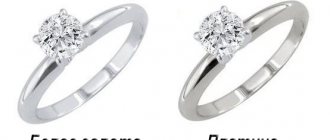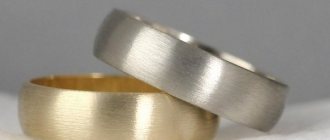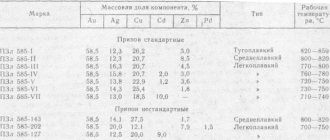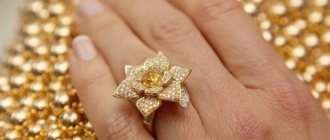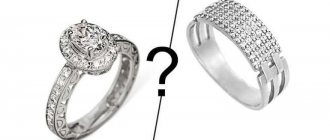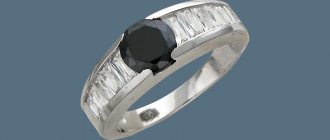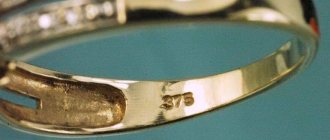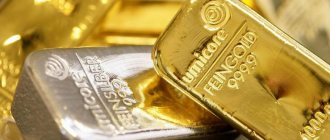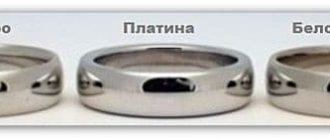Gold is not the only yellow mineral found in nature. Few people know how to tell by eye that a piece of jewelry is made from a gold alloy and that it is not a fake. The physical characteristics of gold and its main alloys are also useful in such a matter as refining gold from radio components. In order not to confuse it with other metals of a similar color, you need to know the density and specific gravity of gold.
general characteristics
In order to understand what platinum is and what white gold is, you need to take a short excursion into history. The fact that gold has been used by mankind has long been known for certain. Archaeological excavations confirm that humanity has not changed at all in its attitude towards gold - the yellow metal has always been held in high esteem. But the attitude towards platinum was not always favorable. During the conquest of America, the Spanish conquistadors considered platinum to be a harmful or “rotten” metal that affected gold. In fact, at that time, technology did not allow the separation of platinum from alloys and other metals, so it turns out that the metal was undervalued for a long time.
It's one thing to counterfeit twenty or hundred dollar bills. The level of financial damage is usually limited to a certain region and affects only a dozen people and a thousand dollars. Secret Service agents quickly notify banks on how to recognize these counterfeit bills and remove them from circulation. There are usually on-site recognition procedures (such as special pens to check paper) to stop their rapid spread. What about gold? It is the most sacred of all commodities because it is considered the most reliable, trusted and valuable store of wealth.A recent news story from October 2009, which was buried under the flood of other media information but became widely known among "big money" brokers and financial kingpins, is only now being released to the public. It concerns the gold at Fort Knox - US Treasury gold - the equivalent of our national wealth. In short, millions (look at the “m”) of gold bars are fake!
Who did this? Obviously our own government.
Background
In October 2009, the Chinese received a shipment of gold bars. Gold is regularly exchanged between countries to pay debts and regulate the so-called trade balance. Most gold is exchanged and stored in safes under the supervision of a special London-based organization, the London Bullion Market Association (or LBMA). When the shipment was received, the Chinese government requested special tests to ensure the purity and weight of the gold bars. To do this, four small holes are drilled into the gold bars and the metal is then analyzed.
Officials were shocked to learn that the gold bars were fake. They consisted of tungsten, only coated on the outside with real gold. Moreover, these gold bars had US registration numbers and were stored at Fort Knox for many years. This Chinese shipment is rumored to have contained 5,600 - 5,700 400 ounce bars (1 ounce of gold equals 31.1034768 grams) each.
At first, many gold experts speculated that the fake gold was produced in China, the world's top producer of counterfeit gold. The Chinese quickly investigated and made a statement that the United States was involved in this scheme.
What have the Chinese revealed?
About 15 years ago in the US during the Clinton administration [think Robert Rubin, Sir Alan Greenspan and Lawrence Summers] some very high-end sophisticated processor produced an estimated 1.3-1.5 million 400-ounce tungsten ingots [more than 16 thousand metric tons ]. Subsequently, 640,000 of these tungsten ingots were plated with gold and sent to Fort Knox, where they remain to this day. According to the Chinese investigation, the remainder of these 1.3 -1.5 million 400-ounce tungsten counterfeits were also gold-plated and then allegedly "sold" on the world market. Apparently the global market is literally "flooded with these 400 ounce salted bars." Possibly worth $600 billion.
A murky press report originally published in the NY Post [written by Jennifer Anderson] in late January 2004 may now make sense.
NYMEX Executive Investigation, Manhattan, New York February 2, 2004.
“A top executive at the New York Mercantile Exchange is being investigated by the Manhattan District Attorney. Sources close to the Exchange said Stuart Smith, senior vice president of exchange operations, was detained last week for a search warrant issued by the District Attorney's office. Details of the investigation were not disclosed, but a NYMEX spokeswoman said it was not related to any exchange market. She declined to comment further other than to say that no charges had been filed. A spokeswoman for the Manhattan District Attorney's office also declined to comment."
The offices of the Senior Vice President of Operations - NYMEX are exactly where you would go to find the records [registration number and origin of the smelter] for EVERY GOLD BAR ever PHYSICALLY traded. They are required to maintain these accounts. These accurate records would show the origin of all the physical gold traded, and would therefore "prove" that the amount of gold in question could not have been provided by American gold mining, because the amount of gold coming from American smelters would undoubtedly be significantly greater than from inland gold mines.
Nobody knows what happened to Stuart Smith. After his offices were raided, he took "administrative leave" from NYMEX and has not been heard from since. It is surprising that the media did not return to the original story, just as nothing else was reported about anything happening at Morgento's DA office, which was executing the search warrant.
Are we to believe that the NYMEX offices are being raided and the head of the offices is taking a leave of absence - is it all just that?
The discovery of counterfeit gold bars also explains another very unusual story that also happened in 2004:
LONDON, April 14, 2004 (Reuters) - NM Rothschild & Sons Ltd., the London-based arm of investment bank Rothschild [ROT.UL], is withdrawing from commodities trading, including gold, in London, it says, to review its operations "
Interestingly, Bill Murphy of GATA reflected on that year in 2004:
“My colleagues and I are wondering today why Rothschild left the gold business right now? This is just a guess on my part, but [I] suspect something has gone wrong. They know that a big scandal is coming, and they don’t want to take part in it... Rothschild wants to get out before the famous “G...o hits the fan.” Bill Murphy. LEMETROPOLE, April 18, 2004.
What is GATA ?
The Gold Antitrust Authority (GATA) is an organization that has been nipping at the heels of the US Treasury Federal Reserve System for the past several years. The basis of GATA's allegations is that these institutions, in coordination with other complicit central and large gold-exchange investment banks in the US, have been manipulating gold prices for decades.
What is GLD ?
GLD is an acronym for London Quality Delivery. The London Bullion Market Association (LBMA) has defined "quality supply" as delivery from an institution that is on their list of suppliers or accepts the standards of the list, and whose bullion has passed the test requirements set by the association and updated from time to time. Ingots must be pure AU from 995.0 to 999.9 grams per 1000. Weight, shape, appearance, marks and weight seals are adjusted as follows:
minimum weight - 350 pure ounces AU; maximum - 430 exact ounces AU, rough weight of the bar is expressed in ounces, multiples of 0.025, rounded down to the nearest 0.025 troy ounce. Dimensions recommended for a “quality delivery” gold bar: main surface 255 x 81 mm; bottom surface 236 x 57 mm; thickness 37 mm.
Purity: Minimum content of 995.0 parts per thousand pure gold. Markings: registration number; manufacturer's hallmark stamp; purity (in four significant figures); year of manufacture (in four digits).
Upon re-examining their prospectus, it becomes fairly clear that GLD was established to purposefully divert investment dollars away from the legitimate pursuit of gold and create a ruse, a sump/receptacle, a slush fund, and the likely destination for many of these counterfeit tungsten bars was that they would never see the light of day, and was hidden behind the following legal "shield" of the law:
[Excerpt from GLD prospectus on page 11]:
“Gold bars held by the Trust in connection with the creation of a Basket may not meet London Quality Delivery standards and, if the Basket is set against such gold, the Trust may suffer losses. Neither the Trustee nor the Custodian independently certifies the purity of the gold bullion deposited into the Trust in connection with the creation of the Basket. Gold bullion held in trust by the Custodian may differ in purity from that stated or in weight from that required by the LBMA gold bullion standards for gold trade or London Quality Delivery Standards, the standards required by the Trust. If, however, the Trustee issues a Basket backed by such gold, and if the Trustee fails to satisfy its obligation to credit the Trust with the amount required for such coverage, the Trust may suffer a loss."
The Federal Reserve knows all this, but is obviously part of the scheme. Recently this year, GATA filed a second Freedom of Information Act (FOIA) request with the Federal Reserve for documents from 1990 to the present relating to gold swaps, gold swaps, or gold swap offerings. The Federal Reserve responded to this FOIA request on August 5, 2009, adding two more documents to those disclosed by GATA in April 2008 under the previous request.
These documents totaled 173 pages, many of which were blacked out (painted over with black paint). The Fed's response also noted that there were still 137 pages of documents remaining undisclosed that it said were not to be made public. GATA challenged this decision on August 20, 2009. The appeal asked for more additional information to prove the validity of this denial and an explanation why some documents, such as one published on the Fed's website discussing gold swaps, were not included in the release of documents dated 5 August.
In a letter on Federal Reserve letterhead dated September 17, 2009, Federal Reserve Governor Kevin M. Warsh rejected GATA's appeal in its entirety. The entire text of this letter is available at www.gata.org. The first paragraph on page three is the most revealing. “In connection with your appeal, I have confirmed that the information denied under clause 4 consists of confidential commercial or financial information relating to the operations of the Federal Reserve Banks that was received within the scope of clause 4. This includes information related to exchange arrangements with foreign banks on behalf of the Federal Reserve System and is not the type of information that is typically disclosed to the public. This information has been duly denied to you.”
The above statements are an admission that the Federal Reserve was involved in the exchange of counterfeit gold bullion and refuses to disclose any information about its actions!
Why was tungsten used?
If you are going to print counterfeit money, you must have special paper, otherwise the bills do not look real and can be easily detected by special pens that most merchants and banks use. Likewise, if you are going to counterfeit gold bars, you must ensure that they have the same weight and properties of real gold.
In early 2008, millions of dollars in gold held by the Central Bank of Ethiopia turned out to be fake. What were supposed to be ingots of solid gold turned out to be nothing more than gilded steel. They tried to sell the material to South Africa and it was sent back when South Africa noticed this little problem. The problem with making good quality counterfeit gold is that gold has a significant density. It is almost twice the density of lead and two and a half times denser than steel. You usually don't notice it because the gold rings and such are small. don't weigh enough to make this fact obvious, but if you've ever held a larger gold bar, you can't go wrong: the material is very, very heavy.
The standard gold bar for interbank trading, known as the London Quality Delivery Bar, weighs 400 ounces (over 15 kg) and is no larger than a pocket-size paperback book. A steel ingot of the same size would weigh only 6 kilograms.
According to gold expert Theo Gray, the problem is that there are very few metals that are as dense as gold, with only two exceptions: they are all worth the same or even more than gold. The first exception is depleted uranium, which is cheap if you're the government, but hard for ordinary people to get. It is also radioactive, which can become a problem. The second exception and the real winner: tungsten. Tungsten is significantly cheaper than gold (about $30 per pound compared to $12,000 per pound for gold). And what’s great is that it has exactly the same density as gold, to the third decimal place. The main differences are that it has the wrong color and is much harder than gold.
A first-class fake gold bar must perfectly match the color, surface hardness, density, chemical, and physical properties of gold. To do this, you must take a tungsten ingot that is 2.54 cm smaller in every dimension than the gold bar you want to counterfeit, and then cover it with the necessary layer of real pure gold. This bar will look good, it will behave like soft gold when struck, it will weigh as expected, it is difficult to say how permeable it will be to an x-ray test. It will be necessary to drill deeply into the ingot to determine that it is a fake. It would cost approximately $50,000 to produce such a high quality fake London Bar "quality delivery" because there is a lot of real gold in it, but you still make a good profit considering the real one costs closer to $400,000.
Now what?
Politicians such as Ron Paul are demanding that the Federal Reserve be more transparent and open its reports to public view. But the Fed has stubbornly refused, saying such disclosures would undermine its operations. Yes, that would certainly be a sensation!
Original article: Fake gold bars in Bank of England and Fort Knox
Pakistan Daily, 11th January 2010
Translation from English: Tamara Baltova, Promt, Multitran and ViMa editors
What is platinum
Among natural minerals, platinum is a very rare metal. But this was not the only reason for its popularity and value. Excellent physical and chemical properties are used in many industries and, most importantly, in jewelry.
To create jewelry, platinum is used as an independent metal and as an additional metal, designed to highlight the beauty of gold. According to its properties, the metal has good plasticity - it is easy to work with. Well, as for the appearance, the exquisite cold shine has always attracted the eye.
What does platinum look like?
The durability of platinum jewelry is much higher than the durability of gold jewelry. This is an expensive metal; as you know, the annual production of platinum is several times less than gold. It also has high anti-corrosion properties - it does not come into contact with oxygen, does not oxidize, and does not irritate the skin. It is not for nothing that the kings of France had one of the largest collections of jewelry made from this metal.
What is white gold
Unlike platinum, white silver is more widely distributed. This is one of the popular jewelry alloys for creating jewelry today. But despite its popularity, when comparing platinum and white gold, you need to understand that white gold is an alloy, and if so, the difference is obvious. White gold does not occur in nature; it is obtained by combining several metals in different proportions. The main component of the alloy is gold, otherwise the alloy would not have such a sonorous name, but the remaining components are metals that are absolutely not related to precious metals - copper, zinc, nickel. And even though silver is present in the recipe, it is not worth calling white gold a noble metal in comparison with platinum. In addition, when comparing the effects of these two metals on the human body, it should be noted that white gold is prone to oxidation, and its constituent zinc and nickel cause an allergic reaction.
Gemini of gold
There are several metals found in nature that have the same density as gold. These are uranium, which is radioactive, and tungsten. It is cheaper than the yellow metal, but the density of tungsten and gold is almost the same, the difference is three tenths. What distinguishes tungsten from gold is that it has a different color and is much harder than the yellow metal. Pure gold is very soft and can be easily scratched with a fingernail.
A fake gold bar filled with tungsten on the inside.
The fact that the density of elements such as tungsten and gold is the same is very attractive to counterfeiters. They replace gold bars with tungsten of similar density and weight, and cover the top with a thin layer of precious metal. At the same time, the high cost of the yellow metal makes tungsten more popular among young people. Tungsten products are much cheaper and more scratch resistant.
Comparative characteristics and differences
To understand more deeply which metal is more valuable, platinum or white gold, you need to consider in detail all the characteristics, from weight and melting point to methods of caring for jewelry.
Compound
The composition of the alloy says a lot about the value of the metal in jewelry. The value of a product has always been higher, the more pure precious metal it contains.
Platinum is a natural metal mined from the earth. It is present in products in the form of pure metal as individual elements and is part of alloys. The most commonly used metal is the highest 950 standard, which means that the platinum alloy contains 95% pure metal.
White gold in the metals and alloys brand has several grades. In jewelry, it is used in samples from 385 to 750. This means that the alloy contains from 38.5% to 75% pure gold. The remaining mass parts are nickel, silver, palladium or platinum.
Therefore, it is not difficult to conclude that it is more expensive; pure metal is always valued.
Strength and weight
The mechanical properties of jewelry are influenced by the metal they are made of. The density of platinum is 21.5 grams/cm3, the density of the same volume of gold is less, only 19.3 grams/cm3. As part of the alloy, the density is even lower; for 583 white gold it ranges from 12.8 grams/cm3 to 14.7 grams/cm3. So the difference between platinum and white gold is obvious - the density of the alloy is almost 50% lower.
Platinum density – 21.5 grams/cm3
The mechanical qualities of metals are also different; the white alloy has more pronounced ductility and is easier to process under pressure. And platinum is characterized by strength and high load resistance. Jewelry made from the alloy is easily deformed, which cannot be said about platinum. Rings, bracelets, and watch cases made of gold require additional polishing 1-2 times a year, but platinum is not prone to damage to the surface, scratches are practically invisible on it.
physical characteristics
Gold is a fairly heavy metal; its density ranks seventh among all metals on the periodic table and is 19.32 g per cubic centimeter. Specific gravity is expressed differently in different unit systems. In the SI system it is newton per meter cubed, but most often jewelers use a non-systemic unit - grams per centimeter cubed. This is done for convenience, so the density will be equal to the specific gravity.
Gold has the following physical properties:
- high strength;
- thermal conductivity;
- electrical conductivity;
- plastic;
- characteristic shine of metal.
The peculiarity of gold is its inertness. It is this characteristic that allows the metal to have the status of noble. This makes it possible to produce gold jewelry, because it does not oxidize and retains its original appearance for a long time. For the jewelry industry, there is only one disadvantage of gold - its softness. This drawback is circumvented by adding other metals to the alloy - alloying, which changes not only this characteristic, but also others: density, melting point.
Studying the quality of a product using special means
Some properties of different grades of gold are presented in the table.
| Try | Brand | Color | Compound | Density g/cm3 | T melt | |
| Silver (+- 0.5%) | Palladium | Nickel | Zinc | |||
| 375 | ZlSrM 375-160 | red | 16 | 11.54 | 880-900 | |
| ZlSrPdM | cream | 10 | 3,5-4,1 | 11.56 | 860-975 | |
| 375-100-38 | ||||||
| 585 | ZlNTsM 585-125-60 | white | 12,0-13,0 | 3,6-4,4 | 12.85 | 870-950 |
| ZlSrPd 585-225-160 | white | 25.5 | Ost. | 14.76 | 1175-1220 | |
| ZlSrM 585-300 | green | 30 | 13.92 | 835-880 | ||
| ZlSrM 585-200 | yellow | 20 | 13.6 | 830-845 | ||
| ZlSrM 585-80 | red | 8 | 13.24 | 880-905 | ||
| 750 | ZlSrNTs 750-125 | white | 12.5 | 15.38 | 900-950 | |
| ZlSrPd 750-100-150 | 15 | Ost. | 16.44 | 1250-1300 | ||
| ZlSr 750-250 | green | 25 | 15.96 | 1040-1045 | ||
| ZlSrM 750-150 | yellow | 15 | 15.45 | 885-900 |
High electrical conductivity characteristics along with inertness have made gold also an industrial metal. In terms of distribution, it is inferior to silver, but surpasses it in another quality: over time, silver oxidizes, but gold does not.
Read also: Vacuum-creating installations with vacuum pressure stabilization
Specific gravity also plays a role in gold mining and in the production of alloys from it. High-quality alloys are obtained only by fusing metals with a small difference in density. Metals with a greater weight than gold can float during melting and form an inhomogeneous structure.
The melting point of gold is 1095 degrees. In addition, there is a hidden melting point. It is measured in kilocalories and represents the energy required to destroy the crystalline structure after the metal has been heated to its melting point. Gold is a diamagnetic metal - a metal that is not attracted to a magnet.
999 gold
In the mid-twentieth century, the United States decided to store the country's gold reserves only in bullion. The weight of the bar was set at 400 troy ounces. Now the mass of a gold bar is 11–13.3 kg. One ounce is 31 grams.
Back in the Middle Ages, the weight of one gold coin was 30 grams, and it turned out that this weight measurement was very convenient for jewelers. It is still in use today. In addition, in the metal stock market, the price of gold is set in dollars per ounce, not per gram. So the mass of gold in the coin is one ounce.
How to determine specific gravity at home?
To do this, you will need scales whose accuracy is about a gram. After weighing into a glass or any other container where there are marks on the volume of liquid, lower the product and see how much the volume has changed. The mass divided by this indicator will be equal to the density of the metal, and accordingly, the specific gravity in units of g/cm?
External features
The difference between the alloy of gold and platinum is also visible in external features. Platinum has a natural white color; in nuggets it is matte, but in products where mechanical processing and polishing were carried out it is glossy, one might even say arrogantly arrogant. White gold is an alloy, and its appearance depends on how many specific parts are in the composition of gold itself, and how much zinc, copper, silver and nickel. The color range ranges from a cool shade of yellow to a pronounced shine with a yellow tint.
It is almost impossible to see white gold in jewelry - the entire surface is covered with rhodium - the surface acquires gloss and additional protection from mechanical damage. But platinum does not require additional protection.
Samples and quality
In jewelry, the hallmarks of platinum and pure gold differ greatly. The difference between platinum is that the most common hallmarks are 950, 900 and 850. If you take into account what hallmark is on the product, you can conclude that the jewelry consists of almost metal without impurities.
For white gold, the highest standard is 750, but this is the highest standard, and so, usually the samples of such metal correspond to 385, 500, 585. It is not difficult to guess the difference; the metal contains from 61 to 41 percent of impurities of other metals.
Production
Platinum and white gold also have different origins. Platinum is usually mined in mines and quarries located close to gold mines. It so happened that this white metal is mined as a mineral in the form of nuggets. Further processing involves cleaning, smelting and machining.
Platinum mining site
White gold is created through the melting process of several metals. Raw materials for the production of jewelry metal are mined in different places, after which the ore is purified and the metal is smelted. And white gold is melted directly at precious metals factories.
As you can see, white gold and platinum have differences in the mining process and production of jewelry metal.
The agony of choice
Fashion for jewelry comes and goes, but silver and gold have been the main materials for the production of jewelry from time immemorial. Why these metals?
We have been producing jewelry for several years, so we can say that any of our gold or silver Solomon’s Rings have a soul: they protect their owner and help him. Like any piece of jewelry, it has a special energy and can become a family heirloom, as a valuable and kind thing that preserves the memory and good wishes of its owner.
Once upon a time three thousand years ago, King Solomon himself wore gold and silver jewelry, and in the modern world these metals are considered special. But with tungsten it is not clear - will it remain a popular material or will it be replaced by a new modern alloy in a couple of years?
Time will show. But gold and silver will wait, why should they rush - after all, eternity has no power over them... Genuine jewelry is above fashion.
Pros and cons of white gold and platinum
When assessing whether white gold or platinum is more valuable, you need to take into account that both metals are classified as precious metals. But when choosing jewelry made of platinum, you should think about the fact that its price, with the same weight as gold, will be higher. Additionally, white gold and platinum have different densities and strengths. White metal does not require additional care efforts; it does not need to be taken to a workshop for polishing. On the other hand, white gold is a more common and more popular material. More gold products are produced, and compared to platinum, such products are cheaper.
But as for investing in jewelry, white gold and platinum have different values - there is a fashion for gold, white gold is popular today, red or green may be tomorrow. But platinum is always in price.
Although, if you ask a woman which jewelry to choose, she will probably say that both white gold and platinum will suit each other perfectly in one ensemble, and they will also look good separately.
How to distinguish real yellow metal from a fake
At the moment, there is a very large percentage of counterfeit gold on both the Russian and foreign markets. There is a huge risk of purchasing gold jewelry containing up to 5% of the precious metal or without it at all. Basic rules when buying gold will help you avoid feeling deceived.
First, you should take a good look at the product. There must be a sample on it. Moreover, it should not consist of crooked numbers or blurry marks. Otherwise, this is the first sign of a counterfeit.
A sample of a unified state hallmark for gold products.
The next sign of a fake is the reverse side of the precious metal jewelry. It must be as well made as the front side, otherwise it is a low-quality product. It is also possible to determine the quality of a product using a characteristic such as gold density, but it is impossible to conduct such an experiment in a store.
There is also a way to determine it, called a strength test. True, it is not always possible to scratch a gold item in front of the seller, so this method cannot be implemented.
Iodine test.
The following chemical methods can serve as good ways to determine the quality of a product. You can drop a little iodine on the yellow metal jewelry. If the speck is dark in color, then we can speak with confidence about the quality of the product being offered. Table vinegar can also help. If, after three minutes spent in it, the precious metal has darkened, then you can safely take the product to a landfill.
Gold chloride can be a great help in determining quality. From the chemistry course, it became known not only the density of gold, but also the fact that it cannot enter into any chemical reactions. Therefore, if after applying gold chloride to a precious metal it begins to deteriorate, then this is a real fake and should belong in the trash.
One of the best ways to protect yourself from purchasing counterfeit goods is to purchase precious metal products in well-known specialized stores.
In this case, there is a high probability of purchasing a truly high-quality product. Even though their price is a little higher than in various shops and markets, the quality is worth it. Otherwise, you can purchase a counterfeit product and very much regret the money saved.
